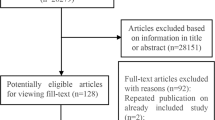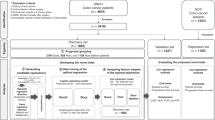Abstract
Background
Evidence of the association between chronic low-grade inflammation, as reflected by C-reactive protein (CRP) measurements, and cancer risk is equivocal. Specifically, few studies have examined this in uncommon cancers and Asian populations.
Methods
We utilised a case-cohort design consisting of multi-types of cancer (N = 3608), and a random subcohort (N = 4432) in a Japanese large population-based study, with a median follow-up time of 15.6 years, and measured baseline plasma CRP using high sensitivity assay. The hazard ratios (HRs) were estimated using weighted Cox proportional hazards methods.
Results
The multivariable-adjusted HR (95% confidence interval) for the top quartile of CRP was 1.28 (1.11‒1.48) (Ptrend < 0.001) for overall cancer compared to the bottom quartile of CRP. Among site-specific cancers, higher CRP levels were associated with an increased risk of colorectal, lung, breast, biliary tract, and kidney cancer, and leukaemia. These positive associations remained among participants after >3 years’ follow-up. Furthermore, subgroup analyses for overall cancer robustly showed a positive association with CRP levels, regardless of sex and obesity.
Conclusion
Our consistent findings suggested that chronic low-grade inflammation measured by CRP is associated with the risk of cancer.
This is a preview of subscription content, access via your institution
Access options
Subscribe to this journal
Receive 24 print issues and online access
$259.00 per year
only $10.79 per issue
Buy this article
- Purchase on Springer Link
- Instant access to full article PDF
Prices may be subject to local taxes which are calculated during checkout

Similar content being viewed by others
Data availability
For information on how to submit an application for gaining access to JPHC data or biospecimens, please follow the instructions at https://epi.ncc.go.jp/en/jphc/805/8155.html.
References
Sung H, Ferlay J, Siegel RL, Laversanne M, Soerjomataram I, Jemal A, et al. Global Cancer Statistics 2020: GLOBOCAN estimates of incidence and mortality worldwide for 36 cancers in 185 countries. CA Cancer J Clin. 2021;71:209–49.
Bray F, Jemal A, Grey N, Ferlay J, Forman D. Global cancer transitions according to the Human Development Index (2008–2030): a population-based study. Lancet Oncol. 2012;13:790–801.
Imhof A, Froehlich M, Brenner H, Boeing H, Pepys MB, Koenig W. Effect of alcohol consumption on systemic markers of inflammation. Lancet. 2001;357:763–7.
Calder PC, Ahluwalia N, Brouns F, Buetler T, Clement K, Cunningham K, et al. Dietary factors and low-grade inflammation in relation to overweight and obesity. Br J Nutr. 2011;106:S5–78.
Egger G, Dixon J. Non-nutrient causes of low-grade, systemic inflammation: support for a ‘canary in the mineshaft’ view of obesity in chronic disease. Obes Rev. 2011;12:339–45.
Balkwill F, Mantovani A. Inflammation and cancer: back to Virchow? Lancet. 2001;357:539–45.
Coussens LM, Werb Z. Inflammation and cancer. Nature. 2002;420:860–7.
Mantovani A, Allavena P, Sica A, Balkwill F. Cancer-related inflammation. Nature. 2008;454:436–44.
McWilliam S, Riordan A. How to use: C-reactive protein. Arch Dis Child Educ Pr Ed. 2010;95:55–8.
Pepys MB. C-Reactive protein fifty years on. Lancet. 1981;317:653–7.
Heinrich PC, Castell JV, Andus T. Interleukin-6 and the acute phase response. Biochem J. 1990;265:621–36.
Pepys MB, Hirschfield GM. C-reactive protein: a critical update. J Clin Invest. 2003;111:1805–12.
Guo YZ, Pan L, Du CJ, Ren DQ, Xie XM. Association between C-reactive protein and risk of cancer: a meta-analysis of prospective cohort studies. Asian Pac J Cancer Prev. 2013;14:243–8.
Choi J, Joseph L, Pilote L. Obesity and C-reactive protein in various populations: a systematic review and meta-analysis. Obes Rev. 2013;14:232–44.
Bhaskaran K, Douglas I, Forbes H, dos-Santos-Silva I, Leon DA, Smeeth L. Body-mass index and risk of 22 specific cancers: a population-based cohort study of 5·24 million UK adults. Lancet. 2014;384:755–65.
Collaboration” NRF. Trends in adult body-mass index in 200 countries from 1975 to 2014: a pooled analysis of 1698 population-based measurement studies with 19·2 million participants. Lancet. 2016;387:1377–96.
Wang Y, Zhang Z, Wang J, Zhang X. Association between C-reactive protein level and subsequent risk of ovarian cancer: A meta-analysis of 13 cohorts in 1,852 ovarian cancer patients. Medicine. 2020;99:e18821.
Zhou B, Shu B, Yang J, Liu J, Xi T, Xing Y. C-reactive protein, interleukin-6 and the risk of colorectal cancer: a meta-analysis. Cancer Causes Control. 2014;25:1397–405.
Wang J, Lee IM, Tworoger SS, Buring JE, Ridker PM, Rosner B, et al. Plasma C-reactive protein and risk of breast cancer in two prospective studies and a meta-analysis. Cancer Epidemiol Biomark Prev. 2015;24:1199–206.
Guo L, Liu S, Zhang S, Chen Q, Zhang M, Quan P, et al. C-reactive protein and risk of breast cancer: a systematic review and meta-analysis. Sci Rep. 2015;5:10508.
Zhou B, Liu J, Wang ZM, Xi T. C-reactive protein, interleukin 6 and lung cancer risk: a meta-analysis. PLoS ONE. 2012;7:e43075.
Tsugane S, Sawada N. The JPHC study: design and some findings on the typical Japanese diet. Jpn J Clin Oncol. 2014;44:777–82.
Budhathoki S, Hidaka A, Yamaji T, Sawada N, Tanaka-Mizuno S, Kuchiba A, et al. Plasma 25-hydroxyvitamin D concentration and subsequent risk of total and site specific cancers in Japanese population: large case-cohort study within Japan Public Health Center-based Prospective Study cohort. BMJ 2018;360:k671.
Kulathinal S, Karvanen J, Saarela O, Kuulasmaa K. Case-cohort design in practice—experiences from the MORGAM Project. Epidemiol Perspect Innov. 2007;4:15.
Aleksandrova K, Boeing H, Nothlings U, Jenab M, Fedirko V, Kaaks R, et al. Inflammatory and metabolic biomarkers and risk of liver and biliary tract cancer. Hepatology. 2014;60:858–71.
Valle JW, Kelley RK, Nervi B, Oh D-Y, Zhu AX. Biliary tract cancer. Lancet. 2021;397:428–44.
Trichopoulos D, Psaltopoulou T, Orfanos P, Trichopoulou A, Boffetta P. Plasma C-reactive protein and risk of cancer: a prospective study from Greece. Cancer Epidemiol Biomark Prev. 2006;15:381–4.
Gu Y, Shore RE, Arslan AA, Koenig KL, Liu M, Ibrahim S, et al. Circulating cytokines and risk of B-cell non-Hodgkin lymphoma: a prospective study. Cancer Causes Control. 2010;21:1323–33.
Brasky TM, Kabat GC, Ho GYF, Thomson CA, Nicholson WK, Barrington WE, et al. C-reactive protein concentration and risk of selected obesity-related cancers in the Women’s Health Initiative. Cancer Causes Control. 2018;29:855–62.
Naugler WE, Sakurai T, Kim S, Maeda S, Kim K, Elsharkawy AM, et al. Gender disparity in liver cancer due to sex differences in MyD88-dependent IL-6 production. Science. 2007;317:121–4.
Castell JV, Gómez-Lechón MJ, David M, Hirano T, Kishimoto T, Heinrich PC. Recombinant human interleukin-6 (IL-6/BSF-2/HSF) regulates the synthesis of acute phase proteins in human hepatocytes. FEBS Lett. 1988;232:347–50.
Hotamisligil GS. Inflammation and metabolic disorders. Nature. 2006;444:860–7.
Hanahan D, Weinberg RA. Hallmarks of cancer: the next generation. Cell. 2011;144:646–74.
Padala SA, Barsouk A, Thandra KC, Saginala K, Mohammed A, Vakiti A, et al. Epidemiology of renal cell carcinoma. World J Oncol. 2020;11:79–87.
Haggar FA, Boushey RP. Colorectal cancer epidemiology: incidence, mortality, survival, and risk factors. Clin Colon Rectal Surg. 2009;22:191–7.
Bade BC, Dela Cruz CS. Lung cancer 2020: epidemiology, etiology, and prevention. Clin Chest Med. 2020;41:1–24.
Doll R, Hill AB. Smoking and carcinoma of the lung; preliminary report. Br Med J. 1950;2:739–48.
Kaneko H, Anzai T, Nagai T, Anzai A, Takahashi T, Mano Y, et al. Human C-reactive protein exacerbates metabolic disorders in association with adipose tissue remodelling. Cardiovasc Res. 2011;91:546–55.
Ockene IS, Matthews CE, Rifai N, Ridker PM, Reed G, Stanek E. Variability and classification accuracy of serial high-sensitivity C-reactive protein measurements in healthy adults. Clin Chem. 2001;47:444–50.
Acknowledgements
We thank the participants and all the staff members in this study. We are indebted to the Aomori, Iwate, Akita, Ibaraki, Niigata, Osaka, Kochi, Nagasaki, and Okinawa Cancer Registries for providing their incidence data. The Japan Public Health Center-based Prospective Study members are listed at the after site: http://epi.ncc.go.jp/en/jphc/781/7951.html.
Funding
This study was supported by the National Cancer Center Research and Development Fund (23-A-31 [toku], 26-A-2, and, 29-A-4), a Grant-in-Aid for Cancer Research from the Ministry of Health, Labour and Welfare of Japan (from 1989 to 2010), and the Practical Research for Innovative Cancer Control (JP16ck0106095 and JP19ck0106266) from the Japan Agency for Medical Research and Development. The funders had no role in study design, data collection, and analysis, decision to publish, or preparation of the study.
Author information
Authors and Affiliations
Consortia
Contributions
SS, RK and TY had full access to all the data in the study and took responsibility for the integrity of the data and the accuracy of the data analysis. Concept and design: SS, RK, TY and M Iwasaki. Acquisition, analysis, or interpretation of data: All authors. Statistical analysis: SS, RK and TY. Drafting of the manuscript: SS drafted the first manuscript with RK support. Critical revision of the manuscript for important intellectual content: All authors. Obtained funding: ST, M Iwasaki. Administrative, technical, or material support: TY, NS, ST and M Iwasaki. Supervision: TY, NS, M Inoue, ST and M Iwasaki.
Corresponding author
Ethics declarations
Ethics approval and consent to participate
All precedures complied with the Helsinki Declaration. The comprehensive study protocol, including this study, was approved by the Institutional Review Board of the National Cancer Center, Tokyo, Japan (Approval No.2011-044). Before initiating this study, all living participants who had provided blood were contacted by mail and given the opportunity to opt-out of participation. Additionally, information on the study was posted on the website of our center to provide participants with the opportunity to opt-out at any time. Respondents who refused to participate were excluded from this study and their withdrawal of consent was documented.
Consent to publish
This manuscript does not contain any individual person’s data in any form, thus, consent for publication was not required.
Competing interests
The authors declare no competing interests.
Additional information
Publisher’s note Springer Nature remains neutral with regard to jurisdictional claims in published maps and institutional affiliations.
Supplementary information
Rights and permissions
About this article
Cite this article
Suzuki, S., Katagiri, R., Yamaji, T. et al. Association between C-reactive protein and risk of overall and 18 site-specific cancers in a Japanese case-cohort. Br J Cancer 126, 1481–1489 (2022). https://doi.org/10.1038/s41416-022-01715-8
Received:
Revised:
Accepted:
Published:
Issue Date:
DOI: https://doi.org/10.1038/s41416-022-01715-8



